Abstract
The change in the surface morphology of the (001) and (110) faces of K2CoxNi(1−x)(SO4)2·6H2O (KCNSH) mixed crystal, depending on the supercooling solution, has been studied under various conditions by laser interferometry. The experiments were carried out in both static mode, by changing the solution composition, and in dynamic mode, by changing the flow velocity. The conditions for the onset and suppression of the reaction of the isomorphic replacement leading to the formation of mosaic micro-inhomogeneity in mixed crystals have been studied. The mechanism of the reaction of isomorphic replacement has been analyzed depending on the shift of the solution composition from the initial one. For the first time, it has been observed that the reaction of isomorphic replacement may occur through a layer-by-layer mechanism.
1. Introduction
Mixed crystals K2CoxNi(1−x)(SO4)2⋅6H2O (KCNSH) are a promising material for UV optical filters for solar-blind technology. Compared with single-component crystals of Tutton sulfate salts, complexes [Ni2+(H2O)6] and [Co2+(H2O)6] have the advantage of being incorporated into the common crystal lattice and suppressing the parasitic bandwidths of each other in the visible spectral region, while transmission in the operating range of 250–290 nm is kept [1]. This significantly increases the efficiency of irradiation filtration. However, at the same time, obtaining perfect KCNSH crystals is associated with a number of difficulties. First of all, there is increased imperfection in such crystals due to the inhomogeneous distribution of isomorphic components, which leads to the generation of internal stresses and, as a consequence, to the cracking of crystals [2]. The strongest sources of elastic stresses in mixed crystals are sectorial and zonal inhomogeneity. In [3,4], a set of measures has been described that make it possible to suppress these types of inhomogeneities (growing crystals in shapers, at a constant temperature, and with supercooling, with solution feeding according to a special law). This resulted in a significant improvement in the structural perfection of the KCNSH crystals; however, it was not possible to completely eliminate their increased fragility. The probable reason for this failure is the peculiarities of the processes of the formation of mixed crystals, which cannot be fully described from the standpoint of the classical theory of crystal growth.
A detailed review of the processes of defect formation in mixed crystals is given in [5]. In general, the fundamental problem of crystallization in multicomponent systems is associated with the presence of additional degrees of freedom in these systems. According to the Gibbs phase rule, a three-component system (for example a solvent (water) and two salts) is characterized by two degrees of freedom (temperature and composition) at constant pressure. Thus, at a certain temperature, there is a continuous series of saturated solutions and crystals in equilibrium with them. If the equilibrium is disturbed as a result of the contact of the crystal with a solution for which the composition does not meet the equilibrium conditions (a “foreign” solution), then complex processes start on the crystal surface, leading to an intense generation of defects.
The mechanism of interaction between mutually nonequilibrium the crystal and solution of isomorphic salt components is studied in detail in [6,7]. This process consists of the following stages: (1) initial dissolution of the crystal and the formation of a highly supersaturated solution of a mixed composition in the boundary layer; (2) crystallization of islands of a new phase, for which the composition is close to the equilibrium in the solution; and (3) the tangential growth of islands on the crystal surface. Thus, the crystal surface turns into a mosaic of local areas where multidirectional processes (growth and dissolution) occur simultaneously. This process is called a reaction of isomorphic replacement.
In particular, according to this model, the deposition of a new crystalline phase is assumed to occur by the 2D nucleation mechanism. This is evidenced by the rough surface of the crystals formed by numerous islands observed in all of the studied systems [8,9,10,11,12,13,14,15,16,17,18]. Instantaneous deposition and rapid growth of numerous islands have also been observed in situ by atomic force microscopy (AFM) [7]. Because of the isomorphic replacement, the crystal surface transforms into a mosaic of randomly scattered areas of various compositions. As a result, a mosaic micro-inhomogeneity is formed in the crystal bulk, a new type of inhomogeneity inherent for mixed crystals only, which was first discovered in [19] and then confirmed in [20,21,22].
The reaction of isomorphic replacement occurs at any point of contact of the crystal with a “foreign” solution. During the growth of a mixed single crystal, the mosaic micro-inhomogeneity can be caused by any instability in the solution flow. For example, instability can occur because of flow turbulence development, the formation of air bubbles on the crystal face and their subsequent separation, etc. The most obvious reason may be the usual reverse stirring of the solution, when the speed of movement drops from the maximum value to zero, and then it starts to move in the opposite direction. In this case, the thickness of the boundary diffusion layer is changing and, as a result, the concentrations of isomorphic components in the solution near the growing crystal surface are changing too [23]. Indirect confirmation of this fact was given in [22]. It is known that the reaction of isomorphic replacement can be suppressed by creating of some critical supercooling in the system [7].
The motivation for the present study is that mosaic micro-inhomogeneity also creates elastic stresses in the crystal and increases its fragility, although to a lesser extent than sectorial and zonal inhomogeneities. Therefore, the goal of this work is to study the conditions for the onset of isomorphic replacement as the root cause of mosaic inhomogeneity, and the conditions for its suppression during the growth of a mixed crystal under compositional and hydrodynamic instability of the growth solution. To do this, the morphology transformation of the K2CoxNi(1−x)(SO4)2·6H2O (KCNSH) crystal faces with a change in the solution flow velocity and its composition (the ratio of isomorphic components) have been studied using a Michelson interferometer.
2. Materials and Methods
Single crystal samples up to 3 mm in dimension, obtained by spontaneous crystallization, were used for the studies. Naturally faceted crystals made it easy to choose the face with the desired indices. The ratio of the isomorphic components K2Co(SO4)2·6H2O (KCSH) and K2Ni(SO4)2·6H2O (KNSH) in the mother solution for growing the specimens was KCSH:KNSH = 1:2 (i.e., KCSH content x = 0.333 weight fraction) and the temperature of the solution saturation was T = 34.5–40 °C. Before the experiment, the solution was filtered using a track membrane with a pore diameter of 0.2 μm.
The experiments were carried out on a setup whose key element was a growth cell installed in one of the arms of a classical Michelson interferometer. The light reflected from the crystal face interacted with the reference beam forming a system of fringes of equal inclination. Observing their changes, one can study the processes of surface transformation. In particular, the normal crystal growth rate, R, is calculated from the rate of change in the intensity of the interference pattern at a given image point. Previously, the growth kinetics of (110) and (001) faces of single-component KCSH and KNSH crystals [24] and KCNSH mixed crystals [25] had been studied in situ by this technique.
To observe the interference, a Ge-Ne (632.8 nm) 15 mW laser was used. The entire setup was placed on an optical passive vibration-damping table, but it was not possible to get rid of the vibrations completely; their source was from a pump supplying the solution to the cell through a hose. This can be seen in the Supplementary video file.
Two types of experiments were carried out: (1) the composition of the stationary solution was being changed under various supercoolings and (2) the flow rate of the solution of the constant composition was being changed under various supercoolings.
2.1. The Procedure of the Experiments with Changing the Solution Composition
The stability of the (001) and (110) faces of the KCNSH crystals was studied during the interaction between the crystal and K2CoxNi(1−x)(SO4)2·6H2O aqueous solutions. The purposes of this experiment were as follows: (1) to detect the reaction of isomorphic replacement during contact of the crystal with a solution of another (different from the mother one) composition, and (2) to estimate the approximate range of supercooling at which the reaction occurs. Therefore, for these experiments, the solutions whose compositions sufficiently differed from the mother solution were used for the crystal growth in the studies. The KCSH weight fractions in these solutions were х = 0.08 and 0.16, the saturation temperature was T = 34.5 °C.
The scheme of the experimental setup is shown in Figure 1. The experiments were performed as follows. At the beginning, a long-term regeneration of the crystal surface in the mother solution was carried out (KCSH:KCSH = 1:2). Then, this solution was poured out and a solution of the studied composition with a given supercooling was poured into the empty cell. There was no stirring of the solution in the cell with the crystal, so the diffusion mode of the crystal growth was realized. The volume of the growth cell (40 mL) was chosen so that the composition of the solution remained virtually unchanged during the experiment. After the end of the experiment, the test solution was drained from the cell and the mother solution was poured into it again so as to regenerate the crystal before the next experiment.
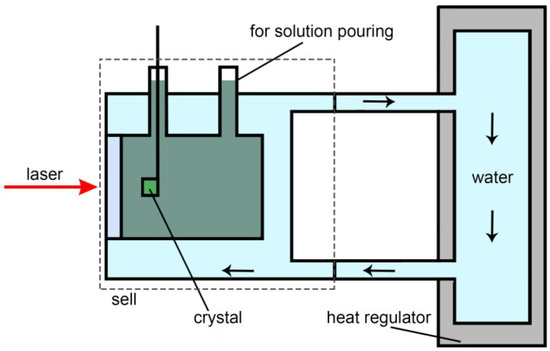
Figure 1.
The scheme of the setup with the cell for studying the growing crystal surface during its interaction with mixed solutions of various compositions.
2.2. The Procedure of the Experiments with Changing the Solution Flow Velocity
The purpose of this experiment was to verify whether the change in the flow velocity could affect the solution composition at the interface and cause a noticeable reaction of isomorphic replacement.
The setup consisted of two parts: a crystallizer (placed in a thermostat) with a pump for supplying the solution to the cell at different flow velocities (Figure 2a) and a flow-through cell (Figure 2b).
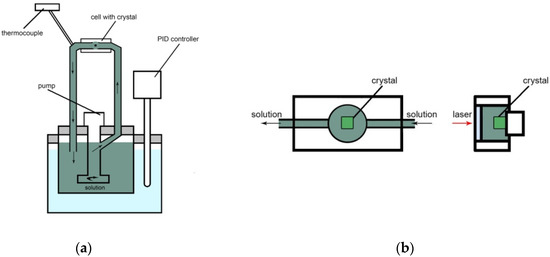
Figure 2.
The schemes of (a) the setup and (b) the cell for studying the growing crystal surface under different solution flow velocities.
KCNSH solutions saturated at T = 40.0 °C were used in these experiments. Before the experiments, the dependence of the normal crystal growth rate on the solution flow velocity was measured so as to determine when the growth process reached the kinetic mode (Figure 3a), when exactly the crystal growth, but not the delivery of the substance to the crystallization front, was the factor limiting the growth rate. One can see that the transition to the kinetic mode occurred at V ≈ 37 cm/s. In the experiments with the change of flow velocity, the values V = 10 cm/s and V = 55 cm/s were chosen as the most distant from the transition point. The kinetic characteristics of the crystal growth at these solution flow velocities were also measured (Figure 3b).
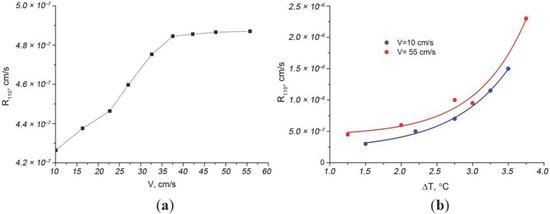
Figure 3.
The dependencies of the normal growth rate (R) of the K2CoxNi(1−x)(SO4)2·6H2O (KCNSH) crystal (a) on the solution flow velocity (V) at supercooling ΔT = 1.5 °C and (b) on the supercooling at different solution flow velocities.
Initially, the crystal surface was regenerated at a low flow velocity (1–2 cm/s). In the experiments, the flow velocity was alternately changed together with the change in solution supercooling. After each change in the flow velocity and supercooling, the crystal was growing for 15 min. The interference pattern from its surface was continuously recorded during this time.
3. Results
3.1. Study of the Surface Morphology of KCNSH Crystal during Contact with Solutions of Various Compositions
A typical response of the (110) KCNSH crystal surface to contact with a mixed “foreign” solution (x = 0.08) at ΔT = 1 °C is shown in Figure 4. The video of the process is posted in the Supplementary Material.
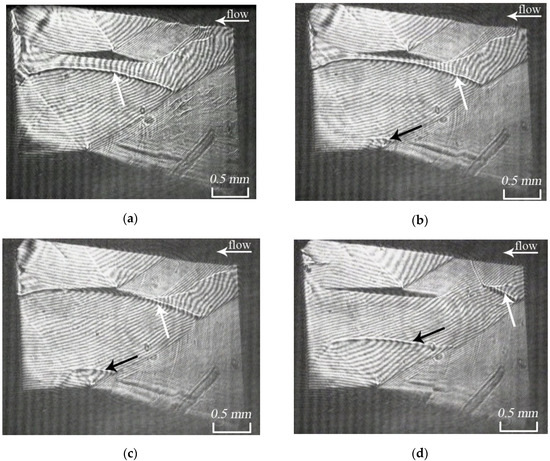
Figure 4.
Interference patterns from the (110) KCNSH crystal surface at (a) 18 s, (b) 101 s, (c) 154 s, and 319 s (d) after contact with the solution at ΔT = 1 °C; the KCSH weight fraction in solution is x = 0.08; white arrow—boundary of the dissolving layer; black arrow—the boundary of the growing layer.
It should be noted that such changes in the surface morphology did not take much time. They lasted for 10 min and were the most intensive for the first two minutes after the start of contact. Initially, a rather slow process of the layer dissolution was propagated from the top of the hillock to its bottom, with a clearly visible boundary (Figure 4). After some time, a layer growth of a new crystalline phase began in the same direction. In general, this looked like the formation of multiple islands on the tops of the original hillocks, as shown by the arrows in Figure 5.
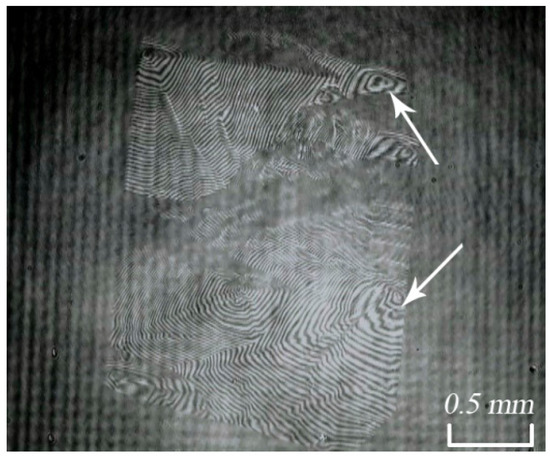
Figure 5.
Interference pattern from the (110) KCNSH crystal surface 43 s after the contact with the solution at ΔT = 0.5 °C; the KCSH weight fraction in the solution is x = 0.16; arrows indicate the tops of the hillocks.
At a higher supercooling, the crystal growth began immediately through the dislocation-spiral growth mechanism without primary dissolution of the surface. The results of the experiments are summarized in Table 1.

Table 1.
Observed processes on the KCNSH crystal surface during contact with solutions of different compositions.
The critical supercooling at which the exchange reaction was suppressed was approximately evaluated (Table 2). The greater the shift in the composition of the studied solution from the initial one (KCSH:KNSH = 1:2), the higher the critical supercooling. It is also noteworthy that critical supercooling depends on the orientation of the crystal face. Its value is higher for the (001) face, so it is more difficult to suppress the exchange reaction in this case.

Table 2.
Approximate evaluation of the critical supercooling for the KCNSH crystals during contact with solutions of different compositions.
3.2. Study of the Surface Morphology of a KCNSH Crystal at a Different Solution Flow Velocity
In the first part of the study, it was found that without forced convection of the solution, the reaction of isomorphic replacement happened actively at ΔT ≤ 1.5 °C, while its weak manifestations were observed up to ΔT = 2 °C. So, for this part of the experiments, we started from the supercooling interval ΔT = 1.3 ÷ 2 °C. When the flow velocity varied at supercooling less than 2.0 °С, the regular interference pattern was violated, which indicated the appearance of numerous local areas of isomorphic replacement (Figure 6a–c). At ΔТ > 2.0 °С, the interference pattern was almost restored. It should be noted that neither layer-by-layer dissolution of the hillock tops nor the growth of new phase layers on them was observed in this case.
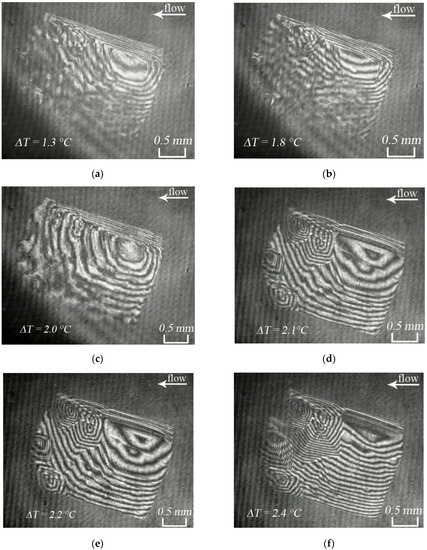
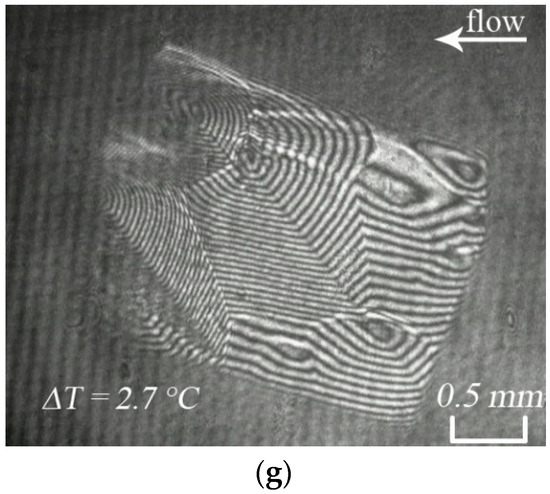
Figure 6.
Interference patterns of the (110) KCNSH crystal surface at flow velocity (a,c,e,g) V = 55 cm/s and (b,d,f) V = 10 cm/s.
The next experiment demonstrated that variations in the flow velocity did not disturb the regularity of the interference pattern at ΔТ > 2.0 °С. The change in supercooling only led to a change in the hillocks slope (Figure 7).
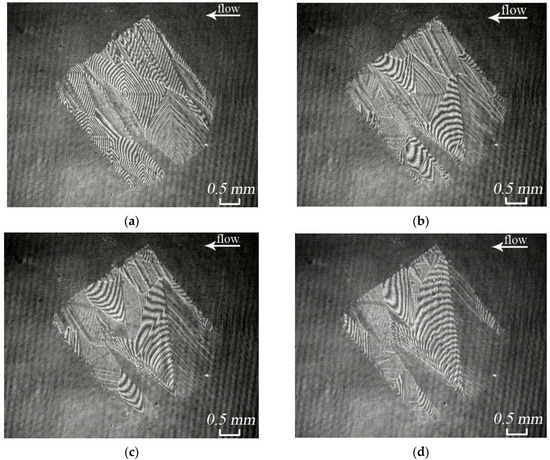
Figure 7.
Interference patterns of (110) KCNSH crystal surface with flow velocity V = 10 cm/s (a,c) and V = 55 cm/s (b,d) and at ΔT = 2.9 °C (a), ΔT = 2.2 °C (b), ΔT = 3.3 °C (c), ΔT = 2.7 °C (d).
The value of critical supercooling depends on the difference between the crystal and the solution composition [10]. Fluctuations in the solution flow velocity lead to fluctuations of the solution composition in the near-surface layer. So, the lower the variations of the flow velocity, the smaller the supercooling that is required for the stable growth of KCNSH crystals. However, it should be concluded that at ΔТ > 2.0 °С, the mosaic micro-inhomogeneity will be suppressed quite reliably.
It is worth noting that the regular pattern of the macrosteps was formed on the growing KCNSH crystal surface in a certain supercooling interval for all of the used flow velocities (Figure 7).The macrosteps were clearly visible even with a closed reference mirror (Figure 8).
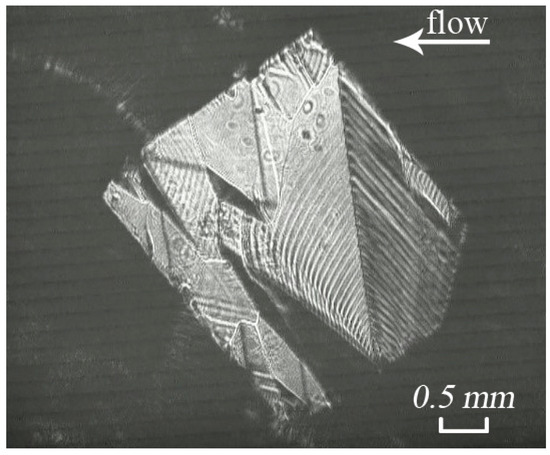
Figure 8.
Macrosteps on the (110) KCNSH crystal surface. Flow velocity V = 10 cm/s. ΔT = 2.1 °C.
Such a macrostep pattern existed in a narrow range of ΔT ~ 2 ÷ 4 °C, regardless of the flow velocity, and created moiré on the interference image. It quickly disappeared when the supercooling left the indicated ΔT range and the crystal surface became smooth again (Figure 9). A return to the specified interval of supercooling led to the reappearance of the described pattern. The nature of this phenomenon is not clear yet and it is a subject to study.
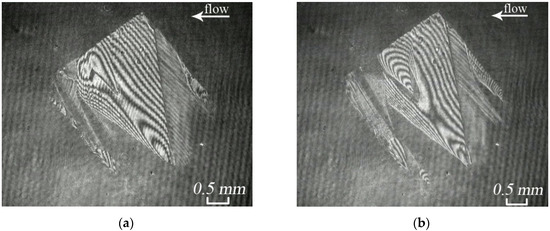
Figure 9.
The (110) KCNSH crystal surface: (a) with flow velocity V = 10 cm/s at ΔT = 3.8 °C, (b) with flow velocity V = 10 cm/s at ΔT = 4.5 °C.
4. Discussion
We estimated the change in the solution composition near the growing KCNSH crystal surface with a change in the flow velocity. Unfortunately, the problem of convective diffusion has not yet been solved for the growth of crystals from a multicomponent solution, so for an approximate analysis, we will used the solution in the Barton–Prim–Slichter model [23]. The capture of an impurity by a growing crystal is considered in this work and it does not completely correspond to our case as the dependence of the crystal growth rate on the solution composition is not taken into account. However, in our case, we used the experimental dependence of the crystal growth rate on the solution flow velocity (Figure 3a). It reflected the dependence of the crystal growth rate on the total supersaturation of the solution, which is determined both by its supercooling and by a change in its composition near the crystal face as a result of a change in the thickness of the diffusion boundary layer.
According to [23], the component concentration at the crystal surface is taken to be the following:
where , , and are the component concentrations in the vicinity of the crystal surface, in a bulk of the solution, and in the solid phase, respectively; R is the normal crystal growth rate; D is the diffusion coefficient of the solution component; and is the thickness of the diffusion boundary layer.
The data on the phase equilibria in the studied system have been obtained in [26,27]. For a KCNSH solution with a KCSH weight fraction x = 0.333, the equilibrium weight fraction of the KCSH in (110) growth sector of the crystal is y = 0.110 [26]. At 40 °C, the equilibrium solution concentrations of KCSH and KNSH are = 5 and = 10 g/100 g H2O [27]. The molecular weights of KCSH and KNSH are g/mol and the density of KCNSH crystal is = 2.24 g/cm3 [26]. Then, the concentrations of the components in the solution and in the crystal, expressed as the number of molecules per cm3, are equal to the following:
The calculations also require the diffusion coefficients of KCSH and KNSH, which are unknown, and the viscosity of our solution required to calculate δ is also unknown. However, as can be seen in Figure 3a, the crystal growth at V = 55 cm/s occurs in the kinetic mode, which is possible when . For our analysis, let us assume = 0.01.
Differentiating both sides of Equation (1) and taking into account the small value of , the formula for estimating the change in the component concentration at the crystal surface with a changing of the flow velocity is as follows:
Here, indexes 1 and 2 correspond to flow velocities of 55 and 10 cm/s, respectively.
In the kinetic mode, the solution concentration at the crystal surface is almost identical to its concentration in the bulk, therefore it is taken to be . So,
The normal crystal growth rates at the considered flow velocities are R1 = 4.9 × 10−7 cm/s and R2 = 4.3 × 10−7 cm/s (Figure 3a), and the diffusion layer thickness is [28], thus 2.35. With these values, is quite small and fulfils the conditions of the approximation used in the derivation of Equation (4). Taking the values for KCSH and KNSH from Equation (2) into the Equation (4), one has = 6.7 × 1019 cm−3 and = 1.1 × 1020 cm−3. So, the cobalt weight fraction near the crystal surface at V = 10 cm/s is estimated as = 0.378. At the same time, as mentioned above, at V = 55 cm/s (kinetic mode), the composition of the solution at the interface corresponds to the initial one, that is, x1 = 0.333. Thus, with a decrease in the flow velocity from 55 cm/s to 10 cm/s, the composition of the salt mass of the solution at the interface changes by Δx = x2 − x1 ≈ (0.378 − 0.333) = 0.045 (4.5 wt.%). It is several times less than in the experiments with a stationary solution, where the tested solutions (x = 0.08 and x = 0.16) differed from the initial one (x = 0.33) by 0.17 and 0.25 (i.e., by 17 and 25 wt.%, respectively).
Thus, taking into account all of the aforesaid, the experiments show that the mechanism of the reaction of isomorphic replacement changes depending on the shift of the solution composition from the initial (mother) one.
In multicomponent systems, the equilibrium conditions are determined not only by the temperature, but also by the compositions of the crystal and solution. It was shown in [29] that when the liquid phase composition deviates from the conditions of equilibrium with the crystal, a compositional undersaturation always occurs (i.e., the crystal dissolves). For a significant difference between the “foreign” and the “equilibrium with the crystal” solution compositions, the dissolution is likely to occur through the formation of negative three-dimensional nuclei (etch pits), and the deposition of a new phase goes by a two-dimensional nucleation mechanism. In this case, characteristic configurations “etch pit − new phase island” are formed as observed, in particular, in [22]. As a result, multi-island structures are formed, which were performed in [6] by the example of the water–salt system of potassium and rubidium acid phthalates (KAP−RbAP).
Undersaturation decreases with a reduction in the composition difference between the “foreign” and the “equilibrium with the crystal” solutions. Then, the crystal dissolution is going on layer-by-layer through the formation of two-dimensional nuclei of dissolution at the hillock top, where the dislocation elastic field additionally shifts the process towards the dissolution. A new phase with a composition different from the original crystal grows layer-by-layer as well. This is confirmed by the fact that, as can be clearly seen in the Supplementary video file, both dissolution and growth occur within the same hillock, occupying its entire surface, which indicates the dislocation-spiral mechanism of these processes. As a result, each island has a center on the hillock top (Figure 5), the number of islands decreases to the number of hillocks on the surface, and their dimensions increase up to the hillock’s ones. This corresponds to the observations [6] where, in Figure 2h, it can be seen that only a few large islands about 1 mm in dimension appeared on the surface, while the solution with a weight ratio KAP:RbAP = 17:83 interacted with the RbAP crystal.
With the solution composition further approaching the equilibrium with the crystal, undersaturation becomes insufficient to remove atoms from the layer, even in the region of dislocation elastic field. In this case, dissolution occurs because of detachment from the crystal of atoms with a higher chemical potential, that is, either by their removal from the step (forming a one-dimensional nuclei) or from the step kink. For this reason, the fluctuations of the relief in Figure 6 are observed statistically over the entire hillock surface, but not at its top, and the dimension of such new formations is much smaller than in the previous case. Judging by the magnitude of bending the interference lines (Figure 6), their dimensions are 100–200 µm, which is consistent with the size of the mosaic elements observed in [22].
The fact that the observed transformation phenomena of the crystal surface can be suppressed by increasing the solution supercooling proves that we are talking precisely about manifestations of the reaction of isomorphic replacement. As the composition of the solution approaches equilibrium with the crystal, the critical supercooling required for this should decrease [5]. However, the supercooling interval ΔT > 2.0 °C should be considered quite reliable for suppressing mosaic micro-inhomogeneity in KCNSH mixed crystals.
5. Conclusions
The stability of the KCNSH crystal surface to local exchange processes was studied by laser interferometry in the static mode for contact with “foreign” solutions, and in the dynamic mode when the velocity of the solution changes. In static mode, when the composition of the salt mass of the solution shifts from the initial one by 17 and 25 wt.%, the processes of crystal dissolution and the growth of a new phase begin at the top of the vicinal hillocks and occur layer-by-layer. It is shown that the greater the shift in the composition of the test solution relative to the initial one, the higher the critical supercooling, which suppresses the reaction of isomorphic replacement. However, at ΔТ > 2.0 °C, the primary dissolution is not observed in all cases—only crystal growth occurs. It is shown that the critical supercooling depends on the crystal face orientation; for the (001) KCNSH crystal face, it is greater than for (110) one, i.e., the exchange reaction on the (001) face is more difficult to suppress.
With a change of flow velocity from 55 cm/s to 10 cm/s, the change in the solution composition at the interface is found to be small, only a few weight percent, which leads to a change in the mechanism of the reaction of isomorphic replacement. In this case, the exchange processes leading to the formation of a phase with a changed composition occur locally on the slopes of the hillocks, supposedly at the step ends. At supercooling above 2 °C, the mixed KCNSH crystal surface is stable; at lower supercooling values, a change in the flow velocity leads to local manifestations of the reaction of isomorphic replacement.
Supplementary Materials
The following are available online at https://www.mdpi.com/2073-4352/10/12/1112/s1, Video S1: Layer-by-layer replacement.
Author Contributions
Conceptualization, A.E.V. and V.V.G.; methodology, V.V.G., M.S.L., S.I.K., and N.A.V.; analysis of results, V.V.G., M.S.L., and A.E.V.; visualization, V.V.G., M.S.L., and N.A.V.; investigation, V.V.G., M.S.L., S.I.K., N.A.V., E.B.R., and V.L.M.; writing—original draft preparation, V.V.G., M.S.L., A.E.V., and N.A.V.; writing—review and editing, V.V.G., M.S.L., N.A.V., E.B.R., V.L.M., and A.E.V.; project administration, A.E.V. All authors have read and agreed to the published version of the manuscript.
Funding
This work was supported by the Ministry of Science and Higher Education of the Russian Federation within the state assignment FSRC (Crystallography and Photonics) RAS.
Conflicts of Interest
The authors declare no conflict of interest.
References
- Vasilyeva, N.A.; Sorokina, N.I.; Antipin, A.M.; Verin, I.A.; Voloshin, A.E. Growth and structure of K2Ni x Co(1–x)(SO4)2·6H2O single crystals. Crystallogr. Rep. 2016, 61, 11–17. [Google Scholar] [CrossRef]
- Koldaeva, M.V.; Руднева, Е.; Manomenova, V.L.; Voloshin, A.E.; Masalov, V.M.; Zhokhov, A.A.; Emelchenko, G.A. Study of the Fracture Toughness of K2NixCo(1–x)(SO4)2·6H2O Crystals in Dependence of the Growth Direction and Rate. Crystallogr. Rep. 2019, 64, 926–931. [Google Scholar] [CrossRef]
- Masalov, V.M.; Vasilyeva, N.A.; Manomenova, V.L.; Zhokhov, A.A.; Rudneva, E.B.; Voloshin, A.E.; Emelchenko, G.A. Growth of mixed K2(Ni,Co)(SO4)2·6H2O crystals under stationary conditions of supercooling and forced convection of the aqueous solution. J. Cryst. Growth 2017, 475, 21–25. [Google Scholar] [CrossRef]
- Voloshin, A.E.; Manomenova, V.L.; Rudneva, E.B.; Vasilyeva, N.A.; Masalov, V.M.; Zhokhov, A.A.; Emelchenko, G.A. Growth of high-perfect mixed K2NixCo1−x(SO4)2·6H2O crystals for fabrication of high-efficiency UV optical filters. J. Cryst. Growth 2018, 500, 98–103. [Google Scholar] [CrossRef]
- Voloshin, A.E.; Руднева, Е.; Манoменoва, В.; Vasilyeva, N.A.; Кoвалев, С.; Emel’Chenko, G.A.; Masalov, V.M.; Zhokhov, A. The Problem of Formation of Mixed Crystals and High-Efficiency K2(Co,Ni)(SO4)2·6H2O Optical Filters. Crystals 2019, 9, 390. [Google Scholar] [CrossRef]
- Glikin, A.; Kovalev, S.; Rudneva, E.; Kryuchkova, L.; Voloshin, A. Phenomena and mechanisms of mixed crystal formation in solutions I. General concept on the example of the system KHC8H4O4–RbHC8H4O4–H2O. J. Cryst. Growth 2003, 255, 150–162. [Google Scholar] [CrossRef]
- Voloshin, A.; Kovalev, S.; Rudneva, E.; Glikin, A. Phenomena and mechanisms of mixed crystal formation in solutions II. Mechanism of interface processes. J. Cryst. Growth 2004, 261, 105–117. [Google Scholar] [CrossRef]
- Anosov, V.Y.; Ozerova, M.I.; Fialkov, Y. A. Foundation of Physical-Chemical Analysis; Nauka: Moscow, Russia, 1976; p. 504. [Google Scholar]
- Glikin, A.E.; Sinai, M.Y. Morphological and genetic classification of crystal substitution products. Zapiski Vsesoyus. Mineral. Obshch. 1991, 120, 3. [Google Scholar]
- Glikin, A.E.; Sinai, M.Y. Experimental study of the genesis of the single crystal pseudomorphs. Zapiski Vsesoyus. Mineral. Obshch. 1983, 112, 742. [Google Scholar]
- Glikin, A.E.; Leontieva, O.A.; Sinai, M.Y. Mechanisms for the exchange of isomorphic components between crystal and solution and macrodefects in secondary crystals. J. Struct. Chem. 1994, 35, 642–646. [Google Scholar] [CrossRef]
- Glikin, A.E. On the theory of formation of isomorphic mixed crystals. Zapiski Vseross. Mineral. Obshch. 1995, 124, 125. [Google Scholar]
- Glikin, A.E. On equilibrium supercooled solutions due to the formation of isomorphic mixed crystals. Zapiski Vseross. Mineral. Obshch. 1996, 125, 103. [Google Scholar]
- Voloshin, A.E.; Glikin, A.E.; Kovalev, S.I.; Rudneva, E.B.; Sinai, M.Y. The mechanisms of formation of mixed crystals in the system biphthalate potassium - rubidium biphthalate. In Proceedings of the IX National Conference on Crystal Growth, Moscow, Russia, 15–20 October 2000; p. 361. [Google Scholar]
- Voloshin, A.E.; Glikin, A.E.; Kovalev, S.I.; Rudneva, E.B.; Sinai, M.Y. The Mechanisms of Mixed Crystals Formation in KAP-RbAP and KDP-ADP Systems. In Proceedings of the ICCG-13, Kyoto, Japan, 30 July–4 August 2001; p. 481. [Google Scholar]
- Kryuchkova, L.Y.; Glikin, A.E.; Voloshin, A.E.; Kovalev, S.I. Kinetic-morphological phenomena of growth and isomorphic substitution of mixed crystals in solutions [by the example of series (Co,Ni)(NH4)2(SO4)2·6H2O]. Zapiski Vseross. Mineral. Obshch. 2002, 131, 62. [Google Scholar]
- Pina, C.M.; Putnis, C.; Pollok, K.; Glikin, A.; Putnis, A. Replacement reactions in the KBr–KCl–H2O system: Experiments and modeling. In Proceedings of the 14th Kongsberg Seminar Spatio-Temporal Patterns in the Earth, Kongsberg, Norway, 7–10 May 2001; p. 31. [Google Scholar]
- Putnis, C.; Pina, C.M.; Pollok, K.; Glikin, A. Mineral replacement reactions in solid solution—Aqueous solution systems II. In Proceedings of the 11th Annual Goldschmidt Conference, Hot Springs, VA, USA, 20–24 May 2001; p. 3555. [Google Scholar]
- Kryuchkova, L.Y.; Glikin, A.E. Variations of the mechanism of single crystal isomorphic replacement. In Proceedings of the Conference Fedorov Session 2010, St. Petersburg, Russia, 11–14 October 2010; p. 111. [Google Scholar]
- Glikin, A.E.; Kryuchkova, L.Y.; Franke, V.D. Phase Relations of Mixed Crystals with Solutions: Characterization and Influence on Crystal Formation. Chem. Eng. Technol. 2011, 34, 587–592. [Google Scholar] [CrossRef]
- Kryuchkova, L.; Sinai, M.; Glikin, A. Compositional distribution of isomorphic crystals during spontaneous crystallization. Acta Crystallogr. Sect. A Found. Crystallogr. 2011, 67, 469. [Google Scholar] [CrossRef]
- Grigoryeva, M.S.; Vasilyeva, N.A.; Artemov, V.V.; Voloshin, A.E. Mosaic microinhomogeneity in crystals of (Co,Ni)K2(SO4)2·6H2O solid solutions. Crystallogr. Rep. 2014, 59, 276–283. [Google Scholar] [CrossRef]
- Burton, J.A.; Prim, R.C.; Slichter, W.P. The Distribution of Solute in Crystals Grown from the Melt. Part I. Theoretical. J. Chem. Phys. 1953, 21, 1987–1991. [Google Scholar] [CrossRef]
- Grebenev, V.V.; Kovalyov, S.I.; Voloshin, A.E.; Manomenova, V.; Руднева, Е.; Vorontsov, D.A.; Vasilyeva, N.A.; Masalov, V.M.; Zhokhov, A.A.; Emelchenko, G.A. Interferometric study of the growth kinetics of K2Co(SO4)2·6H2O and K2Ni(SO4)2·6H2O crystals. Crystallogr. Rep. 2017, 62, 983–992. [Google Scholar] [CrossRef]
- Vorontsov, D.A.; Voloshin, A.E.; Grebenev, V.V.; Vasilieva, N.A.; Kim, E.L.; Manomenova, V.; Руднева, Е.; Masalov, V.M.; Zhokhov, A.A.; Emelchenko, G.A. Growth of faces of K2CoxNi1−x(SO4)2·6H2O mixed crystals. Crystallogr. Rep. 2017, 62, 976–982. [Google Scholar] [CrossRef]
- Руднева, Е.; Manomenova, V.; Koldaeva, M.V.; Sorokina, N.I.; Voloshin, A.E.; Grebenev, V.V.; Verin, I.A.; Lyasnikova, M.S.; Masalov, V.M.; Zhokhov, A.A.; et al. Anomalies of properties in a series of K2CoxNi1−x(SO4)2·6H2O mixed crystals. Crystallogr. Rep. 2017, 62, 928–939. [Google Scholar] [CrossRef]
- Zhokhov, A.A.; Masalov, V.M.; Zverkova, I.I.; Emel’Chenko, G.A.; Manomenova, V.L.; Rudneva, E.B.; Vasilieva, N.A.; Voloshin, A.E. Study of the K2Ni(SO4)2·6H2O–K2Co(SO4)2·6H2O–H2O diagram and determination of the conditions for growing K2(Ni,Co)(SO4)2·6H2O mixed crystals. Crystallogr. Rep. 2016, 61, 1027–1030. [Google Scholar] [CrossRef]
- Levich, V.G. Physicochemical Hydrodynamics; Prentice-Hall: Englewood Cliffs, NJ, USA, 1962; p. 700. [Google Scholar]
- Bolkhovityanov, Y. The contact phenomena between the liquid phase and the substrate during LPE of A3B5 compounds. J. Cryst. Growth 1982, 57, 84–90. [Google Scholar] [CrossRef]
Publisher’s Note: MDPI stays neutral with regard to jurisdictional claims in published maps and institutional affiliations. |
© 2020 by the authors. Licensee MDPI, Basel, Switzerland. This article is an open access article distributed under the terms and conditions of the Creative Commons Attribution (CC BY) license (http://creativecommons.org/licenses/by/4.0/).